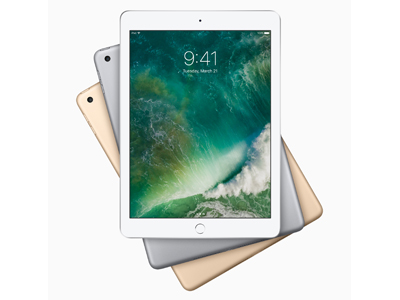
Apple skipped a live event to welcome its newest iPad, and given the new model’s scaled-down specs, it’s easy to see why the company may be saving the fanfare for another time.
Rather than touting a faster, thinner tablet with supreme imaging capabilities, Apple slipped in a thicker, cheaper iPad that has neither its fastest processor nor the best video capabilities. It is, however, now the cheapest 32GB tablet that the company offers; rather than giving its iPad Mini 4 a price cut, Apple instead decided to boost its minimum storage to 64GB.
Why the company decided to add a cheaper tablet, while simultaneously dropping the iPad Air, can be attributed to several factors, according to the research analysts TWICE spoke with.
For one, Apple is facing a declining tablet market. Consumer shipments fell by 11 percent last year, said Mariia Konovalova, Futuresource research analyst, and prices have dropped 52 percent in the past five years. The NPD Group said U.S. dollar sales of tablets are down 14 percent for the 12 months ending February 2017, although the firm does not include Amazon Fire sales in these figures.
“It’s really hard to maintain share in this market,” said Konovalova. “It is not a primary device for consumers, and people are not willing to spend on them as much as on smartphones. Apple now has to compete with market saturation, as well as plenty of lower-priced Android and Windows options. If there is no great driver on the tech side to mitigate increasing or even maintaining prices, then it makes a lot of sense to take the opportunity to increase margins and reduce the price point slightly to better position their premium product against other lower-priced models.”
The price cut also opens new opportunities in emerging markets, said Rhoda Alexander, IHS Markit tablets and PCs director, and incentivizes consumers to refresh their older models.
Eric Smith, Strategy Analytics senior analyst, noted that both iPad Pro models had price decreases within the first six months of being released.
“Without major innovations to get consumers to replace their iPad 2, prices need to fall,” Smith agreed.
See: Apple Joins Wireless Charging Consortium Ahead Of iPhone 8
Speaking of refreshes, it’s likely that it’s the iPad Pro that’s top of mind with the line shake-up, said Stephen Baker, NPD’s VP and technology industry analyst. “By reducing the price and features on the iPad 9.7, they can make the Pro look a little more compelling as an upgrade. It also offers more definition as to why the two are different and could prevent folks from trading down from the Pro to the standard iPad,” he said.
Apple is also working on a new 10.5-inch iPad Pro, said IHS Markit’s Alexander, which may launch as early as late spring. “This shift makes perfect sense in that context, realigning the product family to create room for the new 10.5-inch product and avoiding customer confusion,” she said.
The Pro will need the help, according to Jackson Somes, Gap Intelligence market analyst, who said the iPad Air and Mini models outsold iPad Pros 10-to-1 in the fourth quarter.
“Consumers proved to Apple that they are unwilling to pay the high premium for the company’s top-of-the-line iPad models. Apple’s decision to launch a more affordable tablet demonstrates that Apple can no longer solely rely on a premium assortment in a market that is facing falling prices.”
Smith of Strategy Analytics agreed, noting, “Consumers aren’t enamored with the absolute thinnest tablets available. Adding a little more weight to allow for a faster processor makes much more sense for consumer demand than a thinner profile.”
Branding also likely plays a role: By dropping the Air, Smith argued, consumers no longer have to choose between two premium tablets. “Now the 9.7-inch model is either Pro or not-Pro — leaving Air in the title was a little confusing,” he said.
“To add to the complication,” said Somes, “these names overlapped with the company’s MacBook series with the MacBook Air and MacBook Pro lines. Dropping the Air branding on the iPad line and returning to just iPad simplifies the product lineup, which makes sense for a company that is in constant pursuit of product simplicity.”
As for the iPad Mini 4, the storage boost may not be enough for the model to remain competitive. “I think [the iPad Mini 4 changes] are focused on keeping it relevant and competitive vs. the iPad 9.7,” said NPD’s Baker. “Much of the iPad’s sales challenges in the past year have been due to very weak volume on the Mini, as bigger iPhones and the more attractive feature of the iPad Air 2 squeezed it in the line.”
But, he added, “This probably gives it some additional space to be successful, although I think the Mini will continue to struggle regardless of what Apple does.”
Indeed, Smith noted that 42 percent of tablets shipped globally in 2016 were 9 inches or larger, compared with 34 percent at the peak of the market in 2014.













